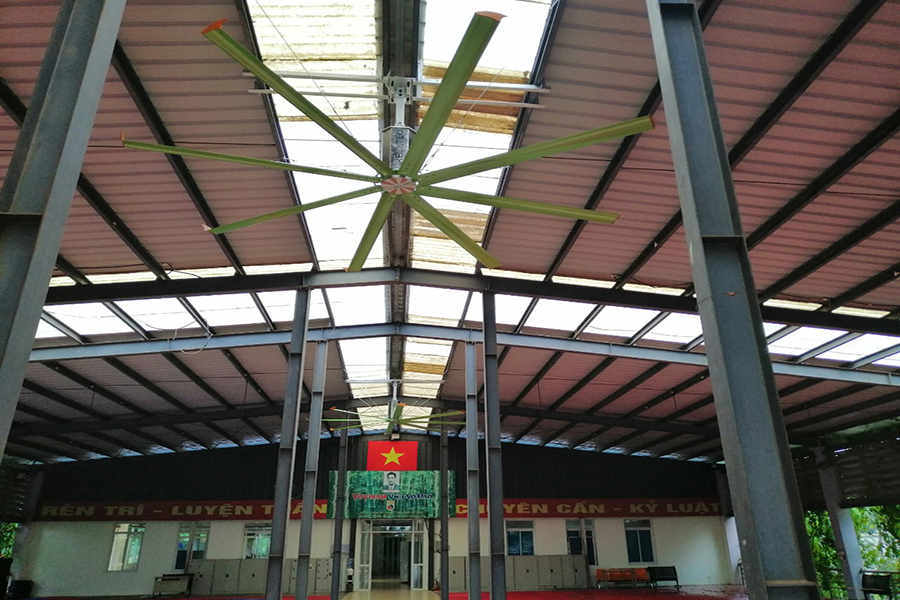
06 Feb Should buy HVLS big ceiling fan few wings
When buying HVLS big ceiling fan, users often prefer reputable brands to ensure the durability and cooling efficiency of the device. One of the topics that many customers are interested in is the question “Should buy some HVLS big ceiling fan”. Check out the article to learn more about industrial ceiling fans so that you can make the most accurate buying decision.
Nội dung bài viết
Ceiling fan should buy a few wings?
Industrial ceiling fans like electric fans such as ceiling fans, standing fans, ceiling fans or table fans, etc. all operate on aerodynamic principles. Before choosing to buy industrial ceiling fans, customers need to learn the main structure and aerodynamic mechanism of electric fans in general and ceiling fans in particular. Depending on the production unit, ceiling fans have their own shape, but they all operate on the same mechanism so there are similarities in structure.
What is aerodynamics
Aerodynamics is the study of the flow of gases. The solution to aerodynamic problems leads to calculations of the various properties of flow, such as velocity, pressure, density and temperature, as functions of space and time. By understanding these properties of gases, one can accurately or approximate the forces and moments of torque on the flow system. Based on aerodynamic studies that can be applied to the optimal shape design for vehicles such as aircraft, cars, high-speed trains … to achieve conditions such as: drag of the lowest air, the lifting force of the airflow when traveling at high velocity.
Industrial ceiling fans also operate on the principle of aerodynamics. When spinning, the blades will push the airflow in a certain direction to create a cool feeling for the room. This is possible thanks to the blades that are angled slightly to the horizontal plane. The direction of the blowing wind will follow the principle of “right hand”. Clench your hand and bring your thumb out, your fingers indicate the direction of rotation of the fan and your thumb will indicate the direction of the wind blowing out. To be more specific and easier to understand, hold your right hand back so that your thumb is pointing at you, now based on the “right hand” principle, the fan is turning counterclockwise and the wind is blowing at you. .
Structure of HVLS big ceiling fan
The structure of industrial ceiling fans usually has main parts such as: electric motors, propellers, control cabinets …
Electric motor
This is the most important part is considered the “heart” of an industrial ceiling fan. This part determines the operation as well as the wind speed of the fan.
Propeller
This is the part that our naked eye can see most clearly of a ceiling fan. Propellers are made of high quality aluminum magnesium alloy specifically used in aircraft manufacturing. With Tubercle design technology to achieve the most efficient airflow.
Control cabinet
The control panel uses an electrical kit with an integrated safety protection module that automatically disconnects the output in case of some accidents. Inverter cabinet brand Yaskawa, Lenze, Japanese brand, Germany.
How many wings are available in HVLS big ceiling fan?
There are many different models of HVLS industrial ceiling fans available. Industrial ceiling fans can have a maximum of 10 blades and at least 2 blades. The first industrial ceiling fans were created with 10 blades. At that time, it was considered the best way to create a large airflow from the fans running at low speed. Over time as the technology was studied, the number of propellers decreased. Most HVLS industrial ceiling fans sold today usually have 5 wings, 6 wings or 8 wings. View now: Some of the best-selling industrial ceiling fan models in 2020
Correlation between propeller and performance
Although the number of blades is the most conspicuous factor related to performance. There are many more important factors that go into how fans create airflow. One factor to consider when evaluating fan airflow is not the number of blades, but the length of the rotor. This is due to a concept called horizontal floor jet.
These jets are horizontal air columns created as a small branch of the fan’s main air column. When that column hits the floor or other objects in its descending path. A long-bladed fan will produce a larger horizontal floor jet than a short-bladed fan. A simple hand calculation can prove that the height of the jet floor is 1/4 day diameter of the fan. Therefore, the floor jet for 24 feet fans will be 6 feet tall and the 6 foot fans will only have 1.5 feet floor jets. It is important to think about the number of blades a fan has for logistics purposes such as installation and installation. However, when it comes to airflow, the length of the blade has more impact.
Manufacturing industrial ceiling fans: an equally important evaluation factor
The way a fan is made also has a huge impact on its performance. No matter how many blades your fan has, if they are not well built. You will be at risk of an accident or malfunction in the future. Look for propellers made of high quality materials – for example, anodized metal will resist more damage and damage than other materials. The extruded impeller also provides a strong uniform airflow for efficient fan operation.
In general, instead of trying to choose a fan with the perfect number of blades, you should find an industrial ceiling fan with the right number of blades with suitable size, firm structure and reliable warranty. will give you peace of mind throughout the life cycle of industrial ceiling fans



No Comments